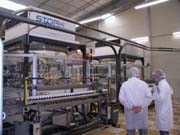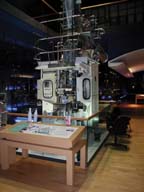From Western France to the World


Focused on Fluid
"When this plant was built in 1968 all French dairy plants were required to produce a full line of products," Coquel says. "But in the 1980s we began to specialize, and the Vitré plant began to focus on fluid milk products."And oh, how it has!
The fourth plastic-bottle filling line was installed at a cost of more than EUR16 million or approximately $19 million. Other improvements are ongoing, including an expansion to the plant's finished product storage facilities.
About 80% of European milk is sold in aseptic, shelf stable packaging. Vitré is 100% UHT aseptic.
"We receive about 17 truck loads of milk per day, or about 1 million liters," Coquel says. "We run round the clock between six and seven days a week and we receive milk every day."
Raw milk is delivered by a fleet of Lactalis's own tanker trucks, most of them adorned with advertising for the company's global brand President, or its French brand Lactel.
The milk is homogenized, and fat levels are set, then it is pasteurized, and sent for storage in one of nine silos until it is needed, generally for a maximum of 24 to 36 hours. For most products the fat level is set to 1.5%, the European standard of "semi-skim."
When the stored milk is needed for filling it is then UHT treated with a Stork serpentine helicolodial system before being sent to fillers.

Let there be light, or not
The Vitré facility has another feature that's rare in U.S. dairy plants-natural light. Many rooms feature frosted glass skylights that let in a soft, diffused natural light that works in conjunction with the plant lighting. In the newest room, large plate glass windows in the walls provide a view of the French countryside while helping to provide a bright, well-lit work environment."Many studies have shown that employees are more productive when they have windows and natural light," Coquel says.
The individual lines are designed to execute uninterrupted runs of 36 to 48 hours, Coquel says. "Afterward we shut down and do a shift of clean in place and maintenance."
The Tetra Pak lines are configured for one-liter baseline bricks, and one-liter square top cartons. Liter packages are typically bundled in six packs, or in three packs. Depending on the products, spout fitments may be applied to cartons and handles can be incorporated in the registered photo-printed overwrap used for bundling the multipacks.

While dairy employees may perform better in a well-lighted facility, dairy products, of course, prefer to be kept in the dark. While UHT milk needs no refrigeration, it may be even more important to protect it from light during its long shelf life. For this reason, a middle layer of carbon black is included as a light barrier in all plastic packages. Some products require protection from oxygen penetration, in which case an additional layer of ethylene vinyl alcohol (EVOH) is used in conjunction with an adhesion layer on either side of it.
For the new line, bottles are blowmolded on two machines, each sporting 14 heads. Each machine can produce 7,000 bottles per hour. All tolled, the plant has 10 blowmolding machines.
"We have become a manufacturer of plastic," Coquel says, noting that the four plastic lines have been added gradually over the last 15 years. "It's a much different operation now."
With shelf stable products, the integrity of the package is extremely important. Blowmolded bottles are tested for leaks in a vacuum chamber before a Posimat uscrambler directs them into a pneumatic conveying system. Plant personnel also do random sampling for structural integrity and wall thickness.

Operators don sterile work clothes before entering the clean rooms.
The Serac fillers are rotary machines with either 24 or 30 heads depending on the line. Each is able to reach a speed of 12,000 to 18,000 bottles per hour.
A foil seal is applied with a pressure/thermal system that heats the top to 220°C for around 4 seconds. As the bottles leave the filler, they are sent to a sleever and heat tunnel for the application of full shrink sleeves, and then a resealable outer cap is applied.
For the Eveil baby formula line, some of the smallest bottles are fitted with a ready-to-use nipple fitment, for sale as a convenience, on-the-go item.

Warehouse and distribution
As with the paperboard packages, most product configurations are bundled into four or six pack multi-packs and a film outer wrap applied. Some products are put into corrugated cases, but many are sent directly to robotic palletizers which are capable of building case-less pallets. Ten separate palletizers are used.With the expansion completed, the Vitré plant will include three storage rooms with enough space to store 20,000 pallets. Sliding pallet racks allow easy inventory maintenance, and, as all product is aseptic, the warehouse utilizes simple climate control, and no refrigeration is needed.
Product is quarantined for a short period while batch samples are tested.
Baby formula products receive the most scrutiny and are held the longest.
From this warehouse space, UHT milk is sent to more than 50 countries around the world. About 20% of the milk and other fluid products packaged in Vitré are destined for export markets. While the Lactel brand is synonymous with milk in France, Lactalis's President brand is used for most of the products sold internationally. In France, President is reserved for cheese products.
In France, products are distributed to a variety of retail outlet types by a Lactalis fleet.
The Vitré plant has been certified to produce pure organic milk since 1995. Raw milk for the Bio Lactel brand, is stored in dedicated silos and processed and packaged on a dedicated line. The plant also utilizes a HACCP plan, and in order to avoid cross contamination, the product flow throughout the plant is configured so that there is no doubling back or crossover.

Plant Facts
Location: Vitré, FranceBuilt: 1968
Recent expansion: Spring 2004
Current Size: 85,000 sq feet
Number of lines: 10
Daily production: 1.5 million liters
Annual milk production:
350 million packages
Employees: 260
Products: 350
Product types: milk, baby formula, organic milk, goats milk, juice

Sidebar: Dairy's History on Display
Groupe Lactalis was founded in 1933 in Laval, France, as a family-owned dairy processing company. Founder André Besnier led the growth of the company into a multi-billion dollar international giant."Mr. Besnier was very proud of how the company had grown and how the dairy industry had evolved during that period, so when he was in his 80s he decided to build a museum that would reflect that," says Luc Morelon, director of communications at Lactalis.
The André Besnier Lactopôle museum, built in 1999, a few years before Besnier passed away, is a legacy not only to the company he built, but also to the dairy industry as a whole.
The museum features a portion of the 180,000 Camembert labels collected by the Besnier family. There are collections of milk cans and butter churns that span most of the 20th century, many of earliest types of centrifuges used to separate milk, and the first Tetra Pak machine used in France.

Much of Lactalis's growth toward becoming a $7 billion company took place through acquisition in the 1980s and ‘90s. At Lactopôle, the history of each of those individual companies is illustrated through a series of displays that also traces the growth of Lactlis.
The museum, which is adjacent to the company's headquarters, is open to the public seven days a week and features a gift shop where visitors can purchase souvenirs and some of Lactalis's award winning products, including its best Camemberts, and cave-aged Roqueforts.
Last year the museum hosted more than 25,000 visitors.
For more information visit www.lactopole.fr.

Lactalis Facts
Headquarters: Laval, FranceFounded: 1933
Ownership: Privately held by the Besnier family
Chief Executive: Michel Léonard
2003 sales: $7.2 billion
Plants: 65 in France, 15 elsewhere
Distribution: About 60% in France, exports to 140 countries
Employees: 16,500
Subsidiary: Sorrento Lactalis, U.S.
Chief Brands: President, Lactel, Bridel, Société, Sorrento
Cheese accounts for 50% of the company's sales. Milk and cream, industrial dairy products, butter and a small amount of veal make up the balance. The President brand is used for multiple product types outside of France, as the word "president" is nearly universally recognized, and has the same meaning and prestige in nearly any language. Lactalis is the second- largest dairy company in France, and among the top 10 in the world.
Vendors
Fillling Equipment:
TetraPak, www.tetrapakusa.com
847/955-6000 (USA)
Serac, www.serac-group.com
(33) 2 43 60 28 28 (FRA)
Blowmolding equipment:
Stork, www.stork-usa.com
(770) 535-1875 (USA)
Controls:
Siemens, www.siemens.com
+49 89 636-00 (GER)
Plastics: BP Solvay, www.solvay.com
Sanitation:
Ecolab, www.ecolab.com
651/293-2233 (USA)
Looking for a reprint of this article?
From high-res PDFs to custom plaques, order your copy today!






